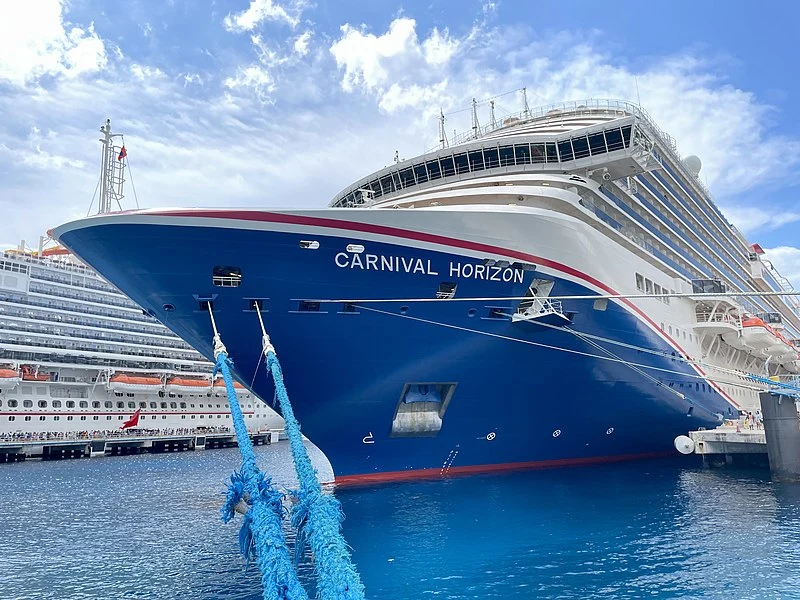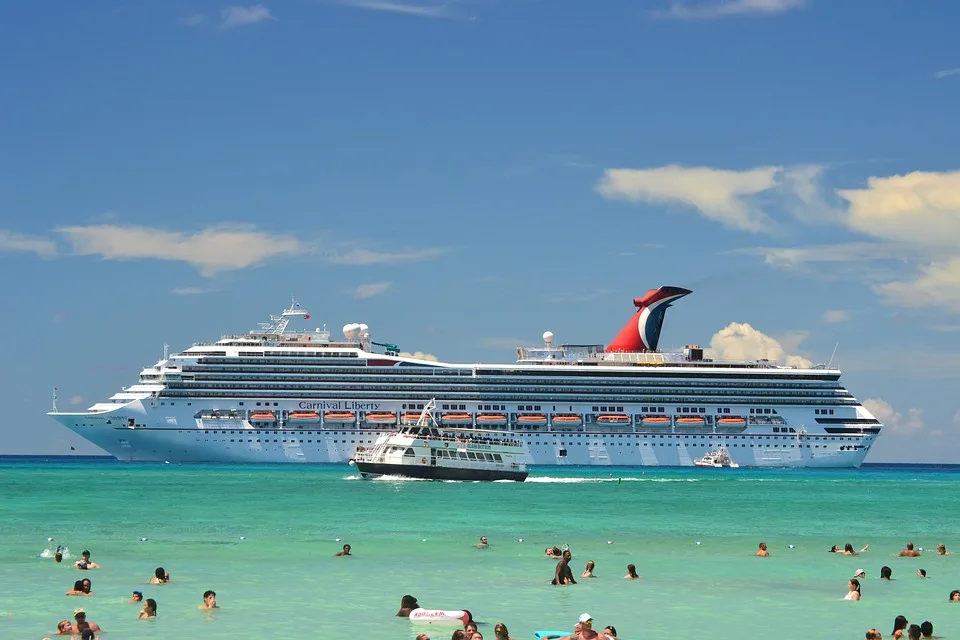There’s nothing quite like living on a cruise ship. It has always been a lavish way to spend a vacation and an unparalleled way to explore the world.
Nobody can argue that cruises make for an excellent vacation, but what about living on a cruise ship? Many people have considered retiring on a cruise ship or simply becoming permanent residents on a cruise ship and with good reason.
The idea of escaping the rat race and living on a cruise ship has appealed to many, as there are so many perks to benefit from. You never have to cook, clean, or even mow the lawn. Dishes and electric bills will be something of the past, and you’ll wake up every day looking out at the most mesmerizing scenes.
Even if you want to continue earning a living without being part of the cruise ship crew, internet access allows thousands of remote employees to live out their days on cruise ships without having to sacrifice their careers.
The first thing people generally think of when considering living on a cruise ship is how much it would cost them. Although many costs associated with living on the land aren’t applicable when you live on a cruise full-time, how much would the average person actually have to pay to live on a cruise ship?
In this post, we explore what onboard spending would entail and what you need to consider when you live full-time on some of the most remarkable cruise ships in the world.

Living Expenses for Life on Cruise Ships
When you visit the websites of cruise lines, you’ll immediately find dozens of very affordable cruise fares. Before going deeper into the matter, it may seem like living on a cruise ship is incredibly cheap.
If you consider a cruise fare of $500 per week, it would cost only $26 000 to live on a cruise ship for a year, which is often less than the rent people pay on land. However, anyone who’s familiar with the cruise industry can tell you that your cruise fare is but a fraction of your expenses onboard.
Double Occupancy Cruise Fare
Only a handful of cruises offer single cabins, so the rates you see in headlines represent only half of what you will be required to pay for your cruise fare alone. Prices are displayed per person, but cabins go for double occupancy rates.
For instance, suppose you come across a cruise fare that’s $600 per person. For a double occupancy cabin, it will actually cost $1200, even if you are just one person sailing. Cruise ships will always require your to pay double. So if you see a favorable cruise fare, be sure to double it to find what you will actually need to pay for a cabin.

Taxes and Port Fees
Everybody pays taxes on nearly everything they purchase, and onboard spending is no different. The difference is that taxes aren’t included in the cruise fare you see on the websites of cruise lines.
Moreover, port fees are also considered an additional cost to the cruise fare and are charged for the privilege of being able to dock at a specific port. Although port fees vary between cruise lines and itineraries, you can expect to pay anything from $100 to $200 per person for a cruise of seven days.
Onboard Gratuities
Although gratuities aren’t technically considered to be a required expense, they are expected of you when you’re staying on a cruise ship, and they can contribute quite a big sum to your overall cost of living on a cruise ship.
Every person is expected to pay between &14 and $17 daily, so a couple sailing on a week-long cruise will have to pay an astounding $200 only in gratuities. If you live on a cruise for a year, gratuities can amount to over $10 000!
Onboard Spending
If you have ever gone on a cruise, you know that there are temptations around every corner and most facilities and activities onboard cost money. If your cruise fare doesn’t cover some of your desired amenities onboard, you can expect to spend quite a lot on certain luxuries.
Things like internet access, drinks, specialty restaurants, and many other expenses are often not included in a basic cruise fare and will require you to pay additional fees. Considering all these factors, we effectively drew up an estimate of how much it would cost to live on a cruise ship for 12 months.
If you’re considering living on a cruise ship for a year, you have a world of options at your disposal regarding cruise lines, departure ports, cruise ships, cabin types, routes, and itineraries. All these things impact how much you will have to spend significantly.
Although there are too many factors at play to calculate a precise cost of living on a cruise ship, we considered the prices of staying aboard a cruise ship of Carnival Cruise Line for a year for the sake of simplicity. Carnival cruises are known to be a bit more affordable than that of other cruise lines.

One of the newer cruise ships by Carnival, Carnival Horizon, sails year-round on six-day and eight-day cruises in 2023. These itineraries mean that passengers can, in theory, sail on the cruise ship for a whole year on the same ship.
As this cruise ship is newer and bigger than many of its sister ships, it features only the best activities, amenities, and restaurants on board.
Most experienced cruisers know that you can save a substantial amount of money if you opt for an inside cabin or a cabin with an ocean view and no windows. However, if you are planning to go on long-term cruises, you may want to have your own balcony to relax on instead of having to head out to the decks for some fresh air.
Suppose a couple is sailing together for a year and staying in the same room. Here is an overview of the criteria chosen for a year-long cruise:
Cruise line: Carnival Cruise Line
Cruise Ship: Carnival Horizon
Sailing Period: From January 2023 to December 2023
Room: Balcony Cabin
Number of passengers: Two
Although the cost of living on a cruise ship will differ from person to person, a general estimate of $145 000 applies to living on this Carnival ship for a year.
Here is a break-down of the expenses you can expect to pay while living aboard a cruise ship:
Cruise Fare: $82 000
Taxes and Port Fees: $15 700
Onboard Gratuities: $10 500
Average Onboard Spending: $37 000

Buying a Cruise Ship Cabin for Retirement
The cost for seniors wanting to live aboard a cruise ship as permanent residents are not as high as you might expect. Several cruise lines offer travelers the opportunity to buy a condo or apartment on the cruise ship, which includes food and many other amenities. Depending on the cabin type, this option can be much more expensive.
For instance, Storylines, a newer cruise line, now offers travelers and retirees the chance to buy condominiums on a cruise ship, with prices starting at $352 000 for a cabin of 172 square feet. Storylines also sells permanent cabins of up to 1690 square feet, with prices starting at $3.2 million.
These prices include all beverages and meals, onboard gratuities, and laundry service for permanent residents. If residents prefer preparing their own meals, the onboard fresh foods market has everything they need. If travelers are able to pay for a condo that includes meals in cash instead of paying it off over a long period, the cost of living on a cruise ship is surprisingly low.
However, annual assessment fees, which include fees for ship supplies, maintenance, and staff salaries, will still apply. The annual assessment fee of this particular cruise line ranges from $70 to $200 per person daily. The yearly cost would then amount to between $25 550 and $74 825.

Instead of booking cruises sailing back-to-back or purchasing a permanent condo, a great alternative is booking many long-term cruises. Oceania Cruises offers an exceptional 180-day world cruise for a reasonable fare of $35 899. The cruise fare includes meals and drinks, along with many other amenities onboard and even airfare for the trip to the port.
If a person were to book two cruises annually, the cost of living on a cruise ship for a year would be approximately $71 798. Compared to traditional retirement, living on a cruise ship like that looks pretty cost-effective, provided you’re comfortable with living in close proximity to other passengers.
Note that if passengers choose to keep the home they own on land while they are living on a cruise ship, their expenses would be much higher. Even if they decide to sell their home, they might still be liable for debt payments and other land-side expenses, including personal items and vehicle storage.
What is Living on a Cruise Ship Like?
Although living on a cruise ship sounds like a dream come true, there are really many factors that may make it less than ideal. However, it entirely depends on each person. Some might be more than happy packing their bags and setting sail for a year or two, while others may grow tired of the limited space and miss their lives on land.
Below are some advantages and disadvantages of living on a cruise ship, so you can gauge whether it is a viable option for you.

Pros of Living on a Cruise Ship
Arguably the best perk of living on a cruise ship is the fact that you get to see the whole world. On a typical cruise, passengers only visit a handful of destinations, whereas residents of a cruise ship get to travel to hundreds of new and exciting places, including Costa Rica, Alaska, Italy, and many more.
Residents of cruise ships also have the chance to partake in countless shore excursions when the ship ports. Long-term cruises, in particular, typically offer a wide range of shore excursions at a discounted rate or even for free!
Beyond the element of adventure, living on a cruise also has some practical benefits. If you are able to continue working while on the cruise ship, you can save quite a lot of the money you would otherwise have to spend on food, gas, and other land expenses.
All your food and entertainment onboard a cruise will be included, so even though the initial sum seems substantial, you save more than you might realize on things like utility costs, gas bills, and groceries.

Cons of Living on a Cruise Ship
Contrary to what many expect, cruise living is not all seashells and sunshine. There are a few disadvantages to consider before committing to a life at sea.
The cost of living on a cruise can be quite drastic, regardless of your spending habits. Medical care, shore excursions, and specialty dining all contribute to a higher cost of living. If your health insurance at home covers international travel, you may be able to exclude medical expenses from your budget, but there are still plenty of other things to think of. Consulting an experienced financial advisor could go a long way in ensuring your financial affairs stay on track.
Since cruise ships have limited space, you should also consider what will happen to your personal belongings when you choose to live on a cruise. You will either need to sell your belongings or rent a storage space.
Another con that keeps many from making the move to the sea is the quality of the medical care onboard cruise ships. Though still excellent, you won’t always have access to more specialized procedures. Before moving to a cruise ship, be sure to discuss the implications with your doctor to ensure you aren’t robbing yourself of the medical care you need.
Living full-time on a cruise may also mean you’re not as physically active as usual, so you will have to stay active and spend time focusing on your health every day aboard the ship.

Cruising for months and even years on end may be the most amazing experience you could ever have. You will get to travel the world in luxury and use all the incredible amenities cruise ships offer to your advantage.
Whether you dream of retiring on a cruise or you just want to set sail for a year, we hope this guide sheds some light on the various factors you need to consider before you go on the adventure of a lifetime.






